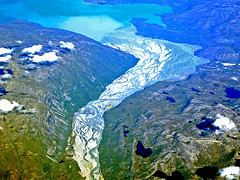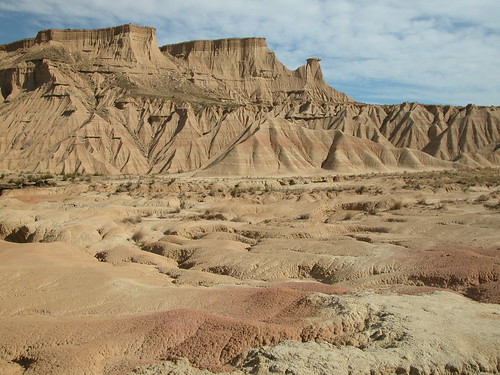【UNFCCC-COP18】系列
歐盟環境總署發表新的評量報告,說明氣候變遷正以冰河融化、格陵蘭冰蓋縮小、海平面上升、積雪減少及永凍層融化等形式影響全歐洲。
這份報告由50位作者共同撰寫,名為《氣候變遷,歐洲的衝擊與弱點2012》(Climate change, impacts and vulnerability in Europe 2012),在卡達杜哈召開的年度聯合國氣候變遷會議前發表。報告中表示整個歐洲都觀測到平均氣溫升高的現象;而降雨量則是呈現在南歐下滑北歐上升的趨勢。
歐盟環境總署執行主任Jacqueline McGlade表示,「氣候變遷是真實的全球現象,且變遷的範圍與速度變得越來越明顯。也就是說在經濟體的每個層面(包括家庭)都需要減少碳排來因應。」
災害頻發區 人類活動增加確定是關鍵因素
近年來,包含熱浪、洪水及乾旱等極端氣候在歐洲各地導致鉅額成本支出。
由於預期極端氣候將更頻繁且劇烈的發生,估計未來的氣候變遷將增加脆弱性。如果歐洲社會不因應,損失將會繼續攀升。
根據歐盟環境總署的這份報告,整體趨勢中氣候變遷扮演的角色究竟佔多大成分,或許需要更多證據確認,但在易發生災害地區,人類活動增加確實是關鍵因子。
報告中表示,一些地區會較其他地區更難適應氣候變遷,整個歐洲的經濟狀況不一是部分原因,而氣候變遷會強化這些差異。
世紀末 歐洲氣溫增加2℃以上
歐洲有史以來最暖的時刻發生在過去十年間(2002~2011年),相較於工業革命前溫度上升了1.3℃。根據不同模式預測結果,本世紀末,歐洲氣溫相較於1961~1990的平均值,將上升2.5~4℃。
過去十年間熱浪發生的越來越頻繁,且時間越來越長,導致數萬人死亡。報告中表示,除非社會因應,否則接下來的數十年更多的熱浪將導致更多人死亡。但相對的,在許多國家因寒冷天候而死亡的人數則會下降。
根據預測,由於溫度的升高加強了水循環,氣候變遷也將使河流氾濫增加,尤其在歐洲北部。
在南歐河流乾旱似乎變得更加嚴重及頻繁。預測在南歐及歐洲的其他地方夏季河流最小流量會減少。
海平面每年上升3公釐
北極暖化的速度比其他地區快。海冰的歷史新低分別發生在2007年、2011年及2012年;約只剩1980年代最低點的一半。
 從1990年代起,格陵蘭的冰帽融化速度倍增,2005~2009年約以每年2500億噸的數量流失;1850年起,阿爾卑斯山的冰河約損失了2/3,而這樣的趨勢仍將持續。
從1990年代起,格陵蘭的冰帽融化速度倍增,2005~2009年約以每年2500億噸的數量流失;1850年起,阿爾卑斯山的冰河約損失了2/3,而這樣的趨勢仍將持續。
海平面則是上升中,致使沿岸地區在風暴侵襲時面臨更多的風險。20世紀全球海平面平均上升了1.7公釐,近數十年間卻每年上升3公釐。
即便對未來的預測有極大的變異存在,但21世紀海平面上升幅度極有可能大於20世紀。海平面上升在歐洲各地差異很大,舉例來說可能會受到區域性土地位移的影響。
報告中表示,結合歐洲疾病預防與控制中心的資料,氣候變遷對人體健康帶來的影響,除了冷、熱溫度的直接影響外,其他間接的影響也是很重要的。
氣候變遷使得硬蜱分佈向北蔓延、隨著越來越溫暖的氣候使得歐洲更多區域成為蚊、蚋等疾病帶原昆蟲分佈範圍更廣、花粉季除了比50年前提早了10天外,影響時間還拉長了,這些都會衝擊人類健康。
許多研究測量植物和動物特徵的變化結果表明,植物提前開花的年份,淡水浮游植物和浮游動物的發生高峰也會提早。
而隨著原棲地溫度提高,許多動植物向北或更高海拔遷移;一些物種遷移的速度跟不上氣候變化的速度,可能會迫使這些物種滅絕。
雖然南歐區能用於農業的水會變少,但其他地區的生長條件將得到會改善。歐洲數種作物的生長期已經增長,且預計這個趨勢將繼續維持;可耕種區域也往北擴充。但在歐洲中部和南部的熱浪與乾旱將致使某些作物的產量下降。
另一方面,溫度上升導致取暖的需求會下降,將會節省能源。但相對的,這部分的能源減少將會被炎熱夏天的降溫需求所消耗的能源抵銷。
這份報告目的在於呈現氣候變遷對整個歐洲的影響,也已提交到歐盟執委會將在2013年3月出爐的「歐洲調適策略」(European Adaptation Strateg)。
要查閱更詳細有關氣候變遷調適措施的訊息,可參考歐盟環境總署建置「氣候適應」網站 http://climate-adapt.eea.europa.eu 。
Climate change is affecting all regions of Europe as glaciers melt, the Greenland ice sheet shrinks, sea levels rise, snow cover decreases and permafrost soils warm, finds a new assessment issued by the European Environment Agency.
The report by 50 authors was published in advance of the annual United Nations climate summit, which opened Monday in Doha, Qatar.
Higher average temperatures have been observed across Europe with decreasing precipitation in southern regions and increasing precipitation in northern Europe, according to the report, “Climate change, impacts and vulnerability in Europe 2012.”
Jacqueline McGlade, executive director of the European Environment Agency said, “Climate change is a reality around the world, and the extent and speed of change is becoming ever more evident. This means that every part of the economy, including households, need to adapt as well as reduce emissions.”
Extreme weather events such as heat waves, floods and droughts have caused soaring damage costs across Europe in recent years.
Future climate change is expected to add to this vulnerability, as extreme weather events are expected to become more intense and frequent. If European societies do not adapt, damage costs are expected to continue rising.
While more evidence is needed to determine the part played by climate change in this trend, growing human activity in hazard-prone areas has been a key factor, according to the EEA report.
Some regions will be less able to adapt to climate change than others, in part due to economic disparities across Europe, and the effects of climate change could deepen these inequalities, the report says.
The last decade (2002–2011) was the warmest on record in Europe, with European land temperature 1.3° C warmer than the pre-industrial average. Various model projections show that Europe could be 2.5–4° C warmer in the later part of the 21st Century, compared to the 1961–1990 average.
Heat waves have increased in frequency and length, causing tens of thousands of deaths over the last decade. The projected increase in heat waves could increase the number of related deaths over the next decades, unless societies adapt, the report says. However, cold-related deaths are projected to decrease in many countries.
Climate change is projected to increase river flooding, particularly in northern Europe, as higher temperatures intensify the water cycle.
River flow droughts appear to have become more severe and frequent in southern Europe. Minimum river flows are projected to decrease in summer in southern Europe but also in many other parts of Europe.
The Arctic is warming faster than other regions. Record low sea ice was observed in the Arctic in 2007, 2011 and 2012, falling to roughly half the minimum extent seen in the 1980s.
Melting of the Greenland ice sheet has doubled since the 1990s, losing an average of 250 billion tonnes of mass every year between 2005 and 2009. Glaciers in the Alps have lost approximately two thirds of their volume since 1850 and these trends are projected to continue.
Sea levels are rising, raising the risk of coastal flooding during storm events. Global average sea level has risen by 1.7 millimeters year in the 20th century, and by three mm a year in recent decades.
Future projections vary widely, but it is likely that 21st century sea-level rise will be greater than during the 20th century. However sea level rise at European coasts varies, for example due to local land movement.
Besides heat-related health impacts, other human health effects are also important, the report says, incorporating information from the European Centre for Disease Prevention and Control.
Climate change allows the tick species Ixodes ricinus to thrive further north, while further warming may make parts of Europe more suitable for disease-carrying mosquitos and sandflies. The pollen season is longer and arrives 10 days earlier than 50 years ago, also affecting human health.
Many studies that have measured changes in plant and animal characteristics show that plants are flowering earlier in the year, while in freshwater phytoplankton and zooplankton blooms are also appearing earlier.
Other animals and plants are moving northward or uphill as their habitats warm. Since the migration rate of many species is not fast enough to keep pace with the speed of climate change, they are being pushed towards extinction.
While there may be less water available for agriculture in southern Europe, growing conditions may improve in other areas. The growing season for several crops in Europe has lengthened and this is projected to continue, alongside the expansion of warm-season crops into more northerly latitudes. But the yield is projected to fall for some crops due to heat waves and droughts in central and southern Europe.
As temperatures rise, demand for heating has also fallen, saving energy. However, this must be balanced against higher energy demands for cooling during hotter summers.
The report is intended to show the full extent of climate change impacts across Europe, also informing the European Commission’s European Adaptation Strategy to be published in March 2013.
The European Environment Agency website Climate-ADAPT offers a large amount of information intended to assist in developing and implementing climate change adaptation.
※ 全文及圖片詳見:ENS








